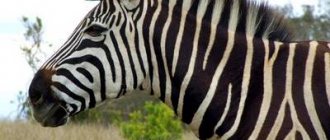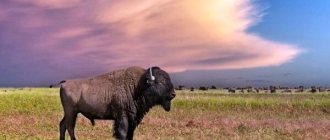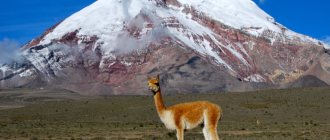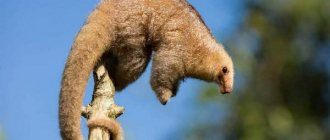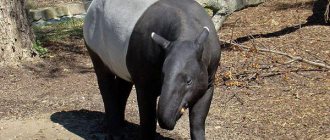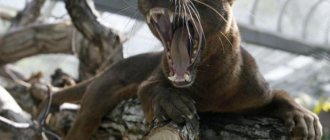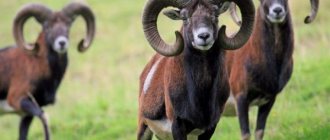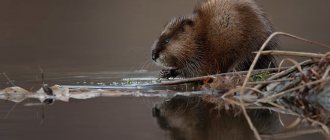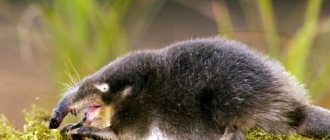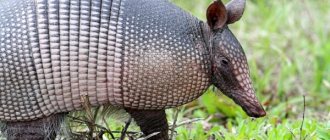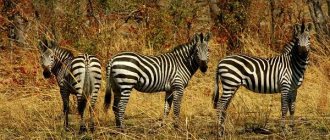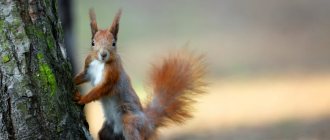Bison (lat.
Bison bison )
is one of the most massive terrestrial animals in the world, belongs to the order Whales, genus Bison, family bovids. In addition to their size, they are known for their prohibitive physical power, huge amount of wool, unique body structure and antiquity, because their remains are found along with the remains of mammoths, which became extinct many thousands of years ago, which indicates the centuries-old existence of bison.
Types of bison
This genus is not distinguished by any large number of different species and subspecies, but has many similarities, both internal, in terms of the type of body structure, and external, with its closest relatives - the bison.
There are only two subspecies in the classification:
Wood
bison ( lat . Bison bison athabascae)
has a relatively small head, a small dark-colored bang on the forehead, over which powerful horns protrude. He has a sparse beard, a small mane on his throat, and dark coat color. The highest part of the hump is located on top of the front legs, and is larger in size than its steppe counterpart.
Steppe
bison ( lat . Bison bison bison)
The head of this animal is noticeably larger than that of the forest subspecies; instead of a bang, there is a dense woolen cap on the forehead, between which horns grow. The beard is quite thick, the mane on the throat is clearly defined and has a lighter color. The dimensions are significantly smaller than the other specimen.
American bison and human interaction
Humans have wiped out wild bison populations. Native Americans of the Midwest hunted these creatures in stable numbers, but with the arrival of Europeans, bison populations became overexploited. Hunting was used to increase economic activity in the area and usually resulted in the slaughter of entire herds.
When a member of the herd was wounded or killed, instead of fleeing, the rest of the herd would gather around the animal, which also made them an easy target. The US government soon became involved and strongly supported the mass killing of American bison. They encouraged hunting to reduce competition for grazing and remove the main prey of the Native Americans. By removing their food source, the Europeans were able to force the Native Americans to live on reservations.
Domestication
The vast majority of the remaining population of this species is farmed privately for human consumption. They are considered semi-domesticated because they have not been domesticated for as long as livestock. Their meat has less fat than beef and more protein. The species is also commonly hybridized with livestock for consumption.
American bison is a good pet
Truly wild bison (without any livestock genetics mixed in) do not make good pets. They are very large, unruly and difficult to keep. Domesticated populations make slightly better pets, but they are not intended for this purpose. They are bred for consumption and meat production, not for docile temperament.
What does it look like
In size, large bisons are significantly larger than their closest relatives, the bison, with which they are often confused. This confusion occurs mainly due to size, a large amount of fur, skeletal structure and the fact that previously bison and bison were practically the same, belonging to the same species, but in the course of evolution they had to separate and become incredibly similar, but still different families .
Due to their mass, they are considered the largest artiodactyls on the entire planet. Their weight reaches one and a half tons, height at the withers is about two meters, body length is on average 2.5-3 meters. Females, in turn, are smaller, often their weight does not exceed 600-800 kg, but there may be exceptions. The color and proportions of these animals are very similar to bison, which is why it will be problematic for an ignorant person to distinguish these species by external features, and in some cases it is simply impossible. The main feature of bison is considered to be high withers, which form a clear and steep hump in the shoulders, as well as a down-turned head with a wide forehead, on which are located very strong, but short horns with ends turned down. In addition, the hairline of this species can also be considered a feature, because there is always more hair on the front part, thereby the body of the animal from the side appears even more massive and intimidating, approaching the hind limbs the amount of fur decreases proportionally in order to rid the animal of excess weight, and also allow it to withstand hot weather. The longest areas of fur are located on the lower part of the neck, chin, forming a fairly large beard, and also on the shoulders. Color can vary from brown to almost completely black. In some places on the body the shade is lighter, usually the shoulders and also the tail. The color on the coat of calves can even be yellow, fading and becoming darker over time. In isolated cases, you can find albino bison, with an almost completely white color.
In the summer season, the animal begins a period of heavy molting, and the fur is separated from the skin in clumps of different sizes. During cold weather, their hair thickens again, thanks to which bison can survive the most severe frosts. The strongest parts of the body, without a doubt, are their huge heads, thanks to which they are able to ram any predator and kill them with just one attack, their massive shoulders, which frighten others with just their appearance, their back, which has to support the entire weight of a giant beast, and also hooves, which do not stand out in size, but have destructive power, easily crushing the skulls of enemies.
The average length of the horns reaches 50-60 cm, but due to their diverging shape, they appear small in size. The length of the tail varies and usually does not exceed 40 centimeters, but there may be exceptions.
Name [edit]
The term "buffalo" is sometimes considered a misnomer for this animal, as it is only distantly related to one of the two "true buffalos", the Asian water buffalo and the African buffalo. However, "buffalo" is a Greek word meaning an ox-like animal, and the word "buffalo" comes from French fur trappers who called these massive beasts bœufs., meaning ox or ox, hence both the names, "bison" and "buffalo" have the same meaning. Although the name "buffalo" may be considered more scientifically correct, as a result of standard usage the name "buffalo" is also considered correct and is listed in many dictionaries as an acceptable name for an American buffalo or bison. In reference to this animal, the term "buffalo" in use in North America dates back to 1635, when the term was first recorded for the American mammal. As such, it has a much longer history than the term "buffalo", which was first recorded in 1774. [9] The American bison is very closely related to the bison or European bison.
Where does it live?
The main habitat can be called North America: many individuals are found from the south of Canada to the most central states of the United States. Wood bison most often live in the northern part in deep forests to avoid attacks from predators and also to hide in the shade of trees from the heat. Plains, or steppe, as they are mostly called, are found in open areas of the south; occasionally they can be found at the beginning of sparse forests, mainly hiding there from not the best weather conditions and trying to find food, which tends to run out. In past centuries, both species roamed from south to north, depending on the season. In times of rain, wind or snow, they tried to live on the plains because it was easy to find food there. When drought began, bison migrated again to the forests to compensate for the lack of moisture by eating tree leaves. At the moment, there are many nature reserves and national parks that artificially limit the territory for life so that animals do not die due to bad weather or poachers.
Distribution of American bison
The true distribution of this species is difficult to determine, mainly because the vast majority are found on private and public lands. While there are approximately 500,000 animals on private lands, it is estimated that only 15,000 are truly wild and free-ranging. Historically, the species ranged from northern Mexico to Canada, but today they are limited to tiny patches of habitat. There is a herd in Mexico, several fragmented herds in the United States, and several fragmented herds in Canada.
What does it eat?
The food of bison depends entirely on weather conditions, as well as the area in which they live. If the climate is normal, then on the plains they like to eat grassy vegetation, but if the weather begins to worsen, they may begin to eat wild fruits that they find, sometimes eat soil to replenish minerals, or migrate to another territory.
Without any problems, this animal eats moss, lichens, ferns and tree foliage along with branches. In winter, they can feed on vegetation that is even under a meter layer of snow.
external reference
- Wikimedia Commons has a multimedia category covering bison
. - Wikispecies has an article on Bison
. - American bison
- National Bison Association
- Buffalo Field Campaign
- Species Profile: American Bison by The Nature Conservancy.
- National Park Service Bison Safety Information in Yellowstone National Park
- The Extermination of the American Bison, William T. Hornaday from Project Gutenberg
- Wild Bison Reference Project - Collaborative Bibliography on the Conservation, Management and Protection of Wild Bison
- American Prairie Foundation
- Papers of buffalo hunter John Wesley Moire, 1871–1917. and undated from the Southwestern Collection, Texas Tech University Special Collections Library.
- Watch the NFB documentary The Great Buffalo Saga.
| Control of authorities |
|
- Data: Q82728
- Multimedia: Bison bison
- Species: Bison bison
Natural enemies
Due to their physical power and external massiveness, these animals have almost no enemies. In extremely rare cases, the forest subspecies is attacked by wild wolves. In the event of predators approaching, the males cover the herd from the back while the females take the young away. The largest alphas stay to fight, the smaller ones try to support them from the side, but do not get involved until the adults give the signal. If the situation is completely dire and there are too many enemies, but there is a body of water nearby, the bison enter the water to save their lives.
Differences from bison
Despite their similarities, European and American bison have a number of physical and behavioral differences. An adult American bison is on average slightly heavier due to its wider frame, although it has shorter legs. American bison tend to graze more and migrate less than their European relatives. Compared to the American bison's muzzle, the European bison's muzzle is further back from the forehead when the neck is in a neutral position. The American bison has a hairier body, although it has less hair on its tail than the European bison. The European bison's horns point forward, making it more adept at fighting. American bison are easier to tame than European bison and are more easily propagated by livestock.
Character traits
At their core, they are herd animals, in many ways similar to bison. When the breeding season has not yet begun, females and males try to stay apart in order to better feed themselves and not worry about others. Representatives of the stronger sex mostly graze alone or in bachelor groups, which usually number no more than fifteen individuals. Females with calves form separate groups of 25-30 animals each, thereby giving them more opportunities to feed their offspring, because they eat significantly less than males.
In general, bison are not known for their aggression and are very balanced animals themselves, avoiding any conflicts whenever possible, even with predators, preferring to run away rather than engage in battle. But in some situations, when the situation is completely hectic, these animals begin to panic and they become very dangerous even for their relatives. Despite their enormous size and weight, they can easily reach speeds of up to 50-60 kilometers per hour, which is not inferior even to horses. In normal times, they use a low moo to communicate, but while running they can exchange short, indistinct sounds that resemble grunting mixed with snoring.
The young animals are very playful and frisky, which is why they often start fights among themselves, which older individuals try with all their might to stop.
A long-standing dispute between zoologists
In the zoological classification, bison and bison differ only at the species level - they have the same family and genus. The difference between them and the possibility of classifying wild bulls as two different species, and not smaller subgroups of one, is still being debated. Research by geneticists has shown a strong similarity in the paternal component of their chromosomes, but a significant difference in the maternal one, which makes it possible not to combine the animals into a group.
Despite this, some scientists have a different opinion - bison and bison are just subspecies. This statement is supported by the fact of free crossing of animals, which as a result produces viable, strong offspring, known as bison.
However, no matter how hard they try to classify them from a scientific point of view, the external differences between the bison and the bison are still obvious.
Lifestyle
During the breeding season or during migration, they unite in huge herds, the number of animals in which often reaches several tens of thousands of individuals. The main one is basically the wisest and oldest male, who may be inferior in strength to others, younger and more massive, but thanks to his experience, he puts the rebels in their place without any problems. If there are too many heads in the herd, several males can be considered as leaders, some of whom will become managers of the most militant and powerful groups who will be responsible for protection from predators, and others - fair coordinators who have long studied the entire territory in the area and know , where the best and most food is, how to quickly escape from enemies, and also how to better take care of each other.
The key reason why these massive animals can begin their migration is the lack of food. Weather conditions contribute to this, but are not the main thing, because thick layers of fat and an abundance of fur allow bison to survive any climatic changes without any problems, but it is climate that affects the rapid disappearance of food, which means that it is because of it that animals have to change their habitat .
Saving [edit]
The herd has since recovered to a total population of about 2,500, largely as a result of conservation efforts by Canadian government agencies. In 1988, the Committee on the Status of Endangered Wildlife in Canada changed the subspecies' conservation status from "threatened" to "threatened", where it remains. [21]
On June 17, 2008, fifty-three Canadian wood bison were transferred from Alberta's Elk Island National Park to the Alaska Wildlife Conservation Center in Anchorage, Alaska. [22] There they were to be quarantined for two years and then again in their natural habitat in the Minto Apartments area near Fairbanks, but this plan was still on hold [23] [24] until April 7, 2015 [ 25] In May 2014, the U.S. Fish and Wildlife Service published a final rule allowing the reintroduction of a “nonessential experimental” population of wood bison in three areas of Alaska. The new resolution came into force on June 6. In the spring of 2015, the Alaska Department of Fish and Game introduced the first herd of 100 animals to the Innoko River region of western Alaska.
Currently, approximately seven thousand wood bison remain in the wild, located in the Northwest Territories, Yukon, British Columbia, Alberta and Manitoba. [26] [27] Additionally, a group of Russian and Korean scientists have proposed the possible extirpation of steppe bison by forest bison in Siberia using cloning techniques. [28]
Return of the bison to Asia[edit]
Forest bison in the Sakha Republic
The reintroduction of wood bison and musk oxen into Yakutia, Russia, was first proposed by zoologist O.V. Egorov in 1963. [29] Compared to the first reintroduction of musk oxen in 1996, an international conservation project created a herd of wood bison. in 2006[30][31][32], where the corresponding steppe bison became extinct more than 6,000 years ago. In 2011, 2013 and 2022, several more bison were sent to Russia from Alberta National Park on Elk Island, bringing the total number of bison to more than 120.[33][34]
As of 2022, the number of bison has increased to over 210 animals and some have been released into the wild. To further strengthen the restoration, the forest bison is officially included in the Red List of Yakutia. [35]
In 2022, 10 young individuals were relocated to remote areas to form a second herd. [36]
Pleistocene Park in Yakutia originally wanted to introduce wood bison into its enclosures, but was unable to do so and instead brought in plains bison with bison.
Reproduction
The breeding season for bison does not change and always runs from May to September; in rare situations when animals are forced to frequently wander from place to place, it can shift by one or two months. During this period, single groups unite and form huge clusters, males begin to look for a female, and the most dominant of them do not hesitate to gather a whole harem around themselves. Although these animals do not particularly like conflicts among themselves, during breeding they organize very brutal fights for the female. The bulls approach each other, after which their noses touch, thereby showing their readiness to fight. They begin to butt heads, resting their foreheads. From the outside, one may get the feeling that due to its size, the battle does not look particularly dynamic, and the animals themselves are too slow to inflict serious wounds, but in fact this is not entirely true. If one of the opponents moves or even falls, the opponent inflicts a blunt and heavy blow on him with his forehead, thereby severely injuring him. Sometimes some individuals die from such fights, but this does not happen too often, because for this the leader of the herd can start a showdown, during which the killer can even be expelled from the group, as a result of which he will have to wander alone.
The gestation period is no different from that of humans and lasts 9 months. Shortly before giving birth, like most other artiodactyls, the female leaves the herd and looks for a secluded place in which to give birth. In rare cases, when there is no normal place nearby or childbirth is about to occur, the female has to give birth in front of everyone, in this case all relatives show interest in the newborn baby and begin to lick it with their rough tongues from head to toe. Usually only one calf is born, but in rare cases even twins can be born. For the first couple of weeks, the cub feeds on its mother's milk, and an hour after birth it begins to take its first steps. The weight of the cub at birth varies from twenty-five to forty kilograms.
Males are polygamous, which is why they do not stick to one female, but on the contrary, they try to find several individuals for intercourse, gathering a full-fledged harem around themselves.
Puberty in bison cubs occurs at three to four years of age; female representatives develop identically to males, unlike many other families.
Caring for American Bison
When caring for bosons, these creatures must have extremely safe enclosures. Livestock are known to destroy fences, and the much larger American Bison are no exception! They are heavy and can easily tear down a fence if damaged. These animals are also known to jump fences up to 6 feet high! Therefore, it is very important to keep them in a safe, properly fenced pasture. They should also be provided with adequate space for grazing and, if necessary, additional hay.
Population and species status
This species is actually millions of years old and has been hunted by the indigenous people of North America since the Stone Age. Drawings on walls depicting bison have been found for a long time and in their antiquity they are no different from drawings of mammoths. When the Indians hunted animals, they did not particularly influence the numbers, because they were not capable of mass destruction of such a huge species, and there was enough meat from one killed animal for several months. Due to the large amount of fur, bison skin was an excellent material for making clothing, as well as jewelry, which only the richest, most skilled or famous people could afford.
The arrival of European colonialists threatened the numbers of all existing wild animals on the American continent, so bison were no exception. White settlers were interested in sights that they had never seen - herds of huge animals, which numbered several thousand individuals. Armed with firearms, the colonialists began the mass extermination of animals for their own amusement, profit and food were just a secondary goal. Bison hunting took place for a long time, and reached its peak during the war of the colonialists against the Indians. In order to deprive the present population of the mainland of food, people began to kill animals without exception, leaving their corpses to rot. Since the Indians did not have time to drag and cut up the carcass, they usually cut out the tongues of animals in order to somehow save themselves from starvation, but the Europeans quickly discovered their method of action, after which they began to cut off the tongues of every animal they killed, thereby completely depriving the indigenous population of at least some provisions. Also, shooting from train windows, the goal of which was to hit as many animals as possible, became an increasingly popular form of entertainment for hunters arriving in America. During such fun, no one even bothered to count the victims they killed, which is why hundreds and thousands of bodies lay in the open sun and rotted, scaring other animals away from this territory. To give an idea of the scale, before Europeans appeared on the American continent, the approximate number of bison was in the region of several tens, maybe even hundreds of millions, but in 1889 they became endangered, and less than a thousand specimens remained. On the territory there were huge mountains of skulls, stretching to the very horizon, on which people stood with a satisfied face, and then used all the bones for the production of fertilizers. This mass destruction led to the extinction of many Indian tribes, and also completely poisoned the entire surrounding territory, which was at least a little cleared only by the twentieth century, and before that it was just an endless wasteland without a hint of life.
Animals were on the verge of extinction by the time national parks were founded, one of which was a park called Yellowstone. It was in it that one of the largest remaining herds, which numbered even less than two hundred individuals, found its refuge. Only thanks to this park, as well as several dozen animals that managed to escape from human atrocities, the number of bison has now been increased to thirty thousand. Now the state of the species, in general, is regarded as quite prosperous, but no one yet plans to remove the animals from the Red Book, because poachers still exist to this day, although instead of fun they are driven by the desire to make money with the help of luxurious bison wool. In addition, approximately five hundred thousand non-purebred individuals are kept on special ranches, races and small competitions are organized with them, in which serious injuries are immediately stopped. Although the species is listed in the Red Book, it is not considered endangered and is used for the production of meat products, like any other cattle. Also, these giant artiodactyls can be found quite often in zoos, and sometimes even in circuses, because they tolerate captivity well.
Lifestyle and habitat
There are areas with different landscapes left for bison to live in, where the animals successfully adapt. Hilly and flat prairies, sparse forests, spruce forests, and national park areas are inhabited by wild giants.
Migrations of large bulls in huge herds are impossible today. Only information remains about the past movements of huge communities of bison of 20 thousand heads. Modern small herds do not exceed 20-30 individuals.
Animals adapt to their living conditions. The thick fur of bison provides warmth in winter from frost. In areas with little snow, bulls find food by digging up snow up to 1 m deep. Grass debris, branches, lichens, and moss save animals from hunger.
The wanton extermination of the animals in the 19th century, which ended at a critical stage in the population in 1891, was carried out without proper study of the mighty bulls. Only 300 individuals from thousands of colonies of wild inhabitants survived the mass extermination.
Therefore, information about the herd hierarchy is contradictory. Researchers argue about the dominant role of the leader. Some believe that this is an experienced cow, others are convinced of the priority importance of old bulls, which perform protective functions in the herd. There are observations of the existence of separate groups consisting of young bulls and cows with calves.
Dimensions do not interfere with the active life of bulls. The bison in the photo is often captured while overcoming water obstacles. They are excellent swimmers and can travel long distances. Coat care is expressed in animals by periodic bathing in dust and sand to kill parasites. The social affection of bison is manifested in the ability to observe newborn cubs. They try to raise their dead relatives by pushing their heads.
The behavior of young animals, especially those who are playful and active in games, is controlled by adults who do not allow them to move away from the herd. Giant bulls have practically no natural enemies, but calves and old animals are hunted by wolves, which get very close in packs.
The bull’s keen sense of smell gives him the main signals – he senses a body of water 8 km away, and the approach of an enemy 2 km away. Vision and hearing play a secondary role. The giant does not attack first; he often prefers to avoid a fight by running away. But increasing tension sometimes leads the animal into a state of aggression.
The excitement of a bison is manifested by a signal of a raised tail, a musky smell, sharp and perceptible at a great distance, a menacing moo or grunt. In a furious attack, the wild bull demolishes everything it encounters on the way. The running speed reaches 60 km/h, the jumping height to overcome obstacles is up to 1.8 m.
Considering that the entire herd is running, it is almost impossible for the enemy to escape from the huge angry mass. But the bison is capable of retreating and fleeing if it senses the advantage of a strong enemy. Animals have the peculiarity of knocking down old and sick individuals to be torn to pieces by predators in order for the strongest individuals to escape.
The bison, an animal of North America , has always been a source of hunting interest among the native Indians. People could cope with the giant only by cunning, driving the bull into pens and abysses. The hunt was carried out on horseback.
The weapons of the brave men were spears, bows, and arrows. Despite their powerful physique, bison can move easily when in danger, trotting or galloping at speeds of up to 50 km/h, outpacing horses. The beast's strength seems to double when the animal is wounded or cornered.
The bison posed a great danger to the hunters themselves, since the behavior of the beast in a ferocious state is unpredictable. The booty in the form of a bison carcass was very significant for the Indians. Of particular value were the tongue and the hump filled with fat. The bull's meat was ground, dried, and stored for the winter.
They made leather from thick skins, sewed outerwear, made saddles, belts, and made tents. The Indians turned tendons into threads and bowstrings; ropes were made from hair; bones were used as material for making dishes and knives. Even animal droppings served as fuel. The death of bison, which became victims of the local population, had no effect on the decline in the population until the barbaric extermination of bulls by shooting began.
Interesting Facts
- A valuable trophy and material for many hunters is the hump, which contains a huge amount of fat, as well as the buffalo tongue, famous for its taste and of particular value among poachers. The Indians often dried the meat taken from the animals they killed for the winter so that they could feed themselves during the severe cold, and by mixing the protein with a rich mixture of fat, which they stored in hard boxes, the result was a very nutritious and warming dish. If it was made from bison meat, it was called pemmican. Such provisions often served as rations during hunting expeditions, and later, when other people arrived on the mainland, polar explorers also used this recipe, since it gave a boost of energy for the whole day in a modest size. From the bones of these massive animals, the Indians often made dishes, other household items, and also weapons, such as knives. Tendons served as a material that replaced threads and was a good string for a bow; the hair was so strong that it was possible to knit full-fledged ropes from it that could withstand enormous weights. The droppings were fuel that was burned on a fire and warmed up, the hooves were ground, boiled and used as a kind of sticky substance, and the skins were used to make leather for tents, clothing and belts.
- A huge number of bones and skeletons of bison were found by scientists underground, which previously contained small but rather deep reservoirs, usually reaching five meters down. As it turned out later, during frequent migration, especially during periods of severe cold, the animals fell through the ice, trying to cross the reservoir in order to find a new place for grazing. It is precisely because of the weight, as well as the large number of herds, that the number of drowning people could reach several tens, and sometimes even hundreds of individuals who were unable to swim out due to, in fact, the inability to swim. They simply never needed to do it, which means evolution never taught them this skill. Only after a lot of time did these animals develop good swimming skills, and they also increased their height and length of jump, thanks to which they were able to jump over a small river.
- In fact, the oldest remains of bison were not found in America. According to the conclusions of archaeologists, zoologists, geneticists and other scientists, the very first individuals lived in South Asia, but after climate change, which began to become hotter due to the increase in earthquakes and volcanic eruptions, the animals were forced to migrate en masse and urgently. In the Pliocene era, which was around 400,000 years ago, there was an ancient land bridge connecting South Asia with America, and it was along this bridge that bison, huge bulls and bison began to roam and quickly move to the American continent. The prehistoric bison, by the way, was much larger than the modern representative of the species; its horns could reach three meters in size from tip to tip, which is as much as six times greater than the size of the horns of modern animals.
- In addition to bison, which are considered the closest possible relatives, bison have other almost indistinguishable cousins - buffalo. All three species have more developed muscles in the forelimbs than in the hind limbs, all of them are covered with a massive layer of fur and belong to the bovid family. The only distinctive features are the horns, which vary in shape and size, depending on the species. For example, steppe bison have short and curled horns, bison have long and straight horns, and buffalo have something in between. Thanks to this, a knowledgeable person can easily distinguish animals from each other, but an ordinary traveler who has not delved too deeply into geography is unlikely to be able to determine exactly which of the three species is now in front of him.
- Bison very rarely open their mouths and mostly communicate with each other using grunts. Males can also demonstrate their physical superiority using this method. They begin to slowly back away, hum hoarsely and lower their heads down, after which they dig the ground with their foreheads. With this gesture, the bull shows that he is interested in the female, and also marks the territory with the smell of his sweat, which often flows down the animal’s forehead due to its dense fur. At any moment, the dominant can fight with another contender for the female if he does not want to retreat immediately after a warning cry, more reminiscent of grunting or sniffling. Battles to the death do not happen often, but their possibility still cannot be ruled out.
Natural history
American bison are herbivores; there are herbs and reeds. Bison mate in August and September; is a polygamist. Their gestation period lasts between 260 and 280 days, after which a single calf is born and cared for for a year. Bison reach maturity at three years of age and have an average lifespan of eighteen to twenty-two years.
These animals were the primary food source for the Native Americans of the Great Plains.
The American bison's habitat consists of river valleys, grasslands, and plains. The most typical habitats are open or semi-open grasslands, as well as sagebrush, semi-arid land, and shrubland. It is also historically known that some lightly wooded areas were home to bison. Bison also graze in mountainous areas where the slopes are not steep. Although they are not particularly known as high-elevation animals, Yellowstone Park's bison herd is often found at elevations above 2,000 meters.
